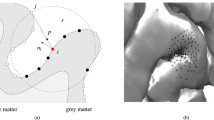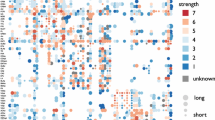Abstract
Examination of the cortico-cortical network of mammals has unraveled key topological features and their role in the function of the healthy and diseased brain. Recent findings from social and biological networks pinpoint the significant role of weak connections in network coherence and mediation of information from segregated parts of the network. In the current study, inspired by such findings and proposed architectures pertaining to social networks, we examine the structure of weak connections in the macaque cortico-cortical network by employing a tract-tracing dataset. We demonstrate that the cortico-cortical connections as a whole, as well as connections between segregated communities of brain areas, comply with the architecture suggested by the so-called strength-of-weak-ties hypothesis. However, we find that the wiring of these connections is not optimal with respect to the aforementioned architecture. This configuration is not attributable to a trade-off with factors known to constrain brain wiring, i.e., wiring cost and efficiency. Lastly, weak connections, but not strong ones, appear important for network cohesion. Our findings relate a topological property to the strength of cortico-cortical connections, highlight the prominent role of weak connections in the cortico-cortical structural network and pinpoint their potential functional significance. These findings suggest that certain neuroimaging studies, despite methodological challenges, should explicitly take them into account and not treat them as negligible.





Similar content being viewed by others
References
Bezgin G, Vakorin VA, van Opstal AJ, McIntosh AR, Bakker R (2012) Hundreds of brain maps in one atlas: registering coordinate-independent primate neuro-anatomical data to a standard brain. Neuroimage 62:67–76
Bota M, Swanson LW (2010) Collating and curating neuroanatomical nomenclatures: principles and use of the Brain Architecture Knowledge Management System (BAMS). Front Neuroinform 4:3
Broder A, Kumar R, Maghoul F, Raghavan P, Rajagopalan S, Stata R, Tomkins A, Wiener J (2000) Graph structure in the web. Comput Netw 33:309–320
Chen Y, Wang S, Hilgetag CC, Zhou C (2013) Trade-off between multiple constraints enables simultaneous formation of modules and hubs in neural systems. PLoS Comput Biol 9:e1002937
Colizza V, Flammini A, Serrano MA, Vespignani A (2006) Detecting rich-club ordering in complex networks. Nat Phys 2:110–115
Csermely P (2006) Weak links: stabilizers of complex systems from proteins to social networks. Springer, Berlin
Cui A, Yang Z, Zhou T (2012) Roles of ties in spreading. arXiv:1204.0100v1
de Reus MA, van den Heuvel MP (2013) Rich club organization and intermodule communication in the cat connectome. J Neurosci 33:12929–12939
Ercsey-Ravasz M, Markov NT, Lamy C, Van Essen DC, Knoblauch K, Toroczkai Z, Kennedy H (2013) A predictive network model of cerebral cortical connectivity based on a distance rule. Neuron 80:184–197
Fries P (2005) A mechanism for cognitive dynamics: neuronal communication through neuronal coherence. Trends Cogn Sci 9:474–480
Gómez-Gardeñes J, Zamora-López G, Moreno Y, Arenas A (2010) From modular to centralized organization of synchronization in functional areas of the cat cerebral cortex. PLoS One 5:e12313
Good BH, de Montjoye Y-A, Clauset A (2010) Performance of modularity maximization in practical contexts. Phys Rev E 81:046106
Goulas A, Bastiani M, Bezgin G, Uylings HBM, Roebroeck A, Stiers P (2014) Comparative analysis of the macroscale structural connectivity in the macaque and human brain. PLoS Comput Biol 10:e1003529
Granovetter M (1973) The strength of weak ties. Am J Sociol 78:1360–1380
Hagmann P, Cammoun L, Gigandet X, Meuli R, Honey CJ, Wedeen VJ (2008) Mapping the structural core of human cerebral cortex. PLoS Biol 6:e159
Harriger L, van den Heuvel MP, Sporns O (2012) Rich club organization of macaque cerebral cortex and its role in network communication. PLoS One 7:e46497
Herculano-Houzel S, Mota B, Wong P, Kaas JH (2010) Connectivity-driven white matter scaling and folding in primate cerebral cortex. Proc Natl Acad Sci USA 107:19008–19013
Hilgetag CC, Barbas H (2006) Role of mechanical factors in the morphology of the primate cerebral cortex. PloS Comp Biol. doi:10.1371/journal.pcbi.0020022
Hilgetag CC, Grant S (2010) Cytoarchitectural differences are a key determinant of laminar projection origins in the visual cortex. NeuroImage 51:1006–1017
Jones DK, Knösche TR, Turner R (2013) White matter integrity, fiber count, and other fallacies: the do’s and don’ts of diffusion MRI. NeuroImage 73:239–254
Kaiser M, Hilgetag CC (2004) Edge vulnerability in neural and metabolic networks. Biol Cybern 90:311–317
Kaiser M, Hilgetag CC (2006) Nonoptimal component placement, but short processing paths, due to long-distance projections in neural systems. PLoS Comput Biol 2:e95
Kaiser M, Görner M, Hilgetag CC (2007) Criticality of spreading dynamics in hierarchical cluster networks without inhibition. New J Phys 9:110
Kaiser M, Hilgetag CC, Van Ooyen A (2009) A simple rule for axon outgrowth and synaptic competition generates realistic connection lengths and filling fractions. Cereb Cortex 19:3001–3010
Leicht E, Newman M (2008) Community structure in directed networks. Phys Rev Lett. doi:10.1103/PhysRevLett.100.118703
Markov NT et al (2011) Weight consistency specifies regularities of macaque cortical networks. Cereb Cortex 21:1254–1272
Markov NT, Ercsey-Ravasz M, Van Essen DC, Knoblauch K, Toroczkai Z, Kennedy H (2013a) Cortical high-density counterstream architectures. Science 342:1238406
Markov NT et al (2013b) The role of long-range connections on the specificity of the macaque interareal cortical network. Proc Natl Acad Sci USA 110:5187–5192
Markov NT et al (2014) A weighted and directed interareal connectivity matrix for macaque cerebral cortex. Cereb Cortex 24:17–36
Maslov S, Sneppen K (2002) Specificity and stability in topology of protein networks. Science 296:910–913
Moretti P, Muñoz MA (2013) Griffiths phases and the stretching of criticality in brain networks. Nat Commun 4:2521
Oh SW et al (2014) A mesoscale connectome of the mouse brain. Nature 508:207–214
Onnela J-P, Saramäki J, Hyvönen J, Szabó G, Lazer D, Kaski K, Kertész J, Barabási A-L (2007) Structure and tie strengths in mobile communication networks. Proc Natl Acad Sci U S A 104:7332–7336
Opsahl T, Colizza V, Panzarasa P (2008) Prominence and control: the weighted rich-club effect. doi:10.1103/PhysRevLett.101.168702
Pajevic S, Plenz D (2012) The organization of strong links in complex networks. Nat Phys 8:429–436
Pérez-Escudero A, De Polavieja GG (2007) Optimally wired subnetwork determines neuroanatomy of Caenorhabditis elegans. Proc Natl Acad Sci USA 104:17180–17185
Perin R, Berger TK, Markram H (2011) A synaptic organizing principle for cortical neuronal groups. Proc Natl Acad Sci USA 108:5419–5424
Santarnecchi E, Galli G, Polizzotto NR, Rossi A, Rossi S (2014) Efficiency of weak brain connections support general cognitive functioning. Hum Brain Mapp. doi:10.1002/hbm.22495
Scannell JW, Blakemore C, Young MP (1995) Analysis of connectivity in the cat cerebral cortex. J Neurosci 15:1463–1483
Shu P, Tang M, Gong K, Liu Y (2012) Effects of weak ties on epidemic predictability in community networks. arXiv:1207.0931v1
Sporns O, Tononi G, Edelman GM (2000) Theoretical neuroanatomy: relating anatomical and functional connectivity in graphs and cortical connection matrices. Cereb Cortex 10:127–141
ter Wel M, Tiesinga P (2012) Phase shifting in a network of cortical circuits and its implications for communication through coherence. Society for Neuroscience, New Orleans, LA. Program/poster 673.11/FF20
van den Heuvel MP, Sporns O (2013a) Network hubs in the human brain. Trends Cog Sci 17:683–696
van den Heuvel MP, Sporns O (2013b) An anatomical substrate for integration among functional networks in human cortex. J Neurosci 33:14489–14500
Vértes PE, Alexander-bloch AF, Gogtay N, Giedd JN, Rapoport JL (2012) Simple models of human brain functional networks. Proc Natl Acad Sci USA 109:5868–5873
Von Bonin GV, Bailey P (1947) The neocortex of macaca mulatta. The University of Illinois Press, Urbana
Womelsdorf T, Schoffelen J-M, Oostenveld R, Singer W, Desimone R, Engel AK, Fries P (2007) Modulation of neuronal interactions through neuronal synchronization. Science 316:1609–1612
Zhao M, Zhou C, Lü J, Lai CH (2011) Competition between intra-community and inter-community synchronization and relevance in brain cortical networks. Phys Rev E 84:016109
Zingg B, Hintiryan H, Gou L, Song MY, Bay M, Bienkowski MS, Foster NN, Yamashita S, Bowman I, Toga AW, Dong H-W (2014) Neural networks of the mouse neocortex. Cell 156:1096–1111
Acknowledgements
We would like to thank Claus C. Hilgetag for feedback on a previous draft of the manuscipt.
Author information
Authors and Affiliations
Corresponding author
Electronic supplementary material
Below is the link to the electronic supplementary material.
Rights and permissions
About this article
Cite this article
Goulas, A., Schaefer, A. & Margulies, D.S. The strength of weak connections in the macaque cortico-cortical network. Brain Struct Funct 220, 2939–2951 (2015). https://doi.org/10.1007/s00429-014-0836-3
Received:
Accepted:
Published:
Issue Date:
DOI: https://doi.org/10.1007/s00429-014-0836-3




